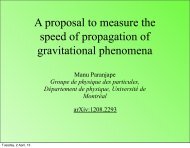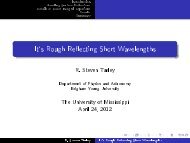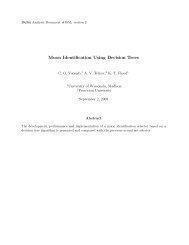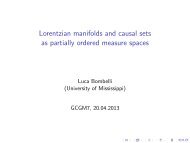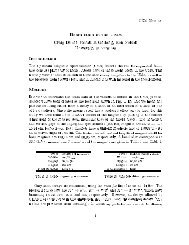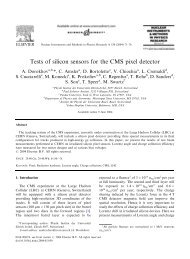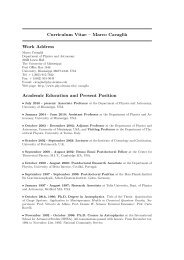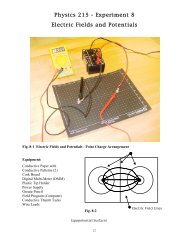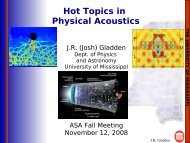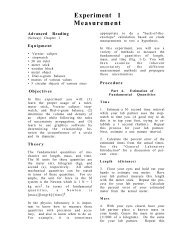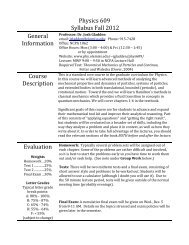High Temperature Resonant Ultrasound Spectroscopy (RUS) Methods
High Temperature Resonant Ultrasound Spectroscopy (RUS) Methods
High Temperature Resonant Ultrasound Spectroscopy (RUS) Methods
Create successful ePaper yourself
Turn your PDF publications into a flip-book with our unique Google optimized e-Paper software.
<strong>High</strong> <strong>Temperature</strong> <strong>Resonant</strong> <strong>Ultrasound</strong><br />
<strong>Spectroscopy</strong> (<strong>RUS</strong>) <strong>Methods</strong><br />
– Introduction<br />
Guangyan Li, Rasheed Adebisi, Josh Gladden<br />
Department of Physics<br />
The University of Mississippi<br />
Outline<br />
– Potentials of <strong>RUS</strong> methods in high-temperature physics<br />
– Design and fabrication of high temperature direct contact <strong>RUS</strong> probe<br />
– Current and future research<br />
– Elastic constant measurements of thermoelectric (TE) materials<br />
– Summary
Introduction I:<br />
Modulus of Linear Elasticity<br />
Strain:<br />
Generalized Hooke's Law:<br />
Reduced index form:<br />
Isotropic materials:<br />
ij = 1 2 u i , ju j ,i <br />
ij<br />
=c ijkl<br />
kl<br />
11 1, 222,33 3, 234, 31 5,12 6<br />
c 11,<br />
c 44
Introduction II:<br />
<strong>Methods</strong> for Measuring Elastic Constants<br />
Mechanical methods for measuring elastic constants:<br />
●<br />
●<br />
●<br />
Quasi-static method<br />
Pulse-echo method<br />
Resonance method<br />
v= C ij<br />
<br />
– Natural frequencies depend on geometry, density, elastic<br />
constants
Introduction to <strong>Resonant</strong> <strong>Ultrasound</strong><br />
<strong>Spectroscopy</strong> (<strong>RUS</strong>)<br />
<strong>RUS</strong> technique uses resonance spectra of elastic bodies to infer material properties<br />
such as elastic moduli<br />
Typical <strong>RUS</strong> procedures:<br />
– Prepare the specimen – cutting & polishing<br />
– Get the dimensions, shape, density, crystallographic<br />
orientation etc.<br />
– Drive the specimen over a swept frequency range<br />
– Identify the resonance peaks<br />
– Adjust the material parameters (elastic constants) to<br />
best fit the experimental resonance spectrum in the<br />
least square sense<br />
Synthesizer<br />
PC<br />
(GPIB)<br />
Lock-in<br />
Amplifier<br />
Transducer<br />
Sample<br />
Transducer<br />
<strong>RUS</strong> system diagram<br />
Four normal modes of a parallelepiped
Advantages Over Other Ultrasonic <strong>Methods</strong><br />
●<br />
●<br />
●<br />
●<br />
●<br />
Obtain a full elastic tensor in one frequency sweep<br />
<strong>High</strong>est accuracy<br />
Fast (partly due to modern computing power)<br />
No bond between the sample and the transducer<br />
Works well with small (sub-mm) & low-symmetry crystals<br />
<strong>RUS</strong> cell with<br />
PVDF transducers<br />
DRS Q9000 <strong>RUS</strong><br />
System transducers<br />
Transducer on a stage<br />
Mid-temperature<br />
direct-contact transducers
Representative Resonance Spectra<br />
Ideal vs. bad
<strong>High</strong> <strong>Temperature</strong> <strong>RUS</strong> System<br />
<strong>High</strong>-temperature <strong>RUS</strong> system
Potentials of <strong>RUS</strong> <strong>Methods</strong> in<br />
<strong>High</strong>-temperature Physics<br />
●<br />
●<br />
●<br />
<strong>RUS</strong> has been valuable for the study of condensed matter physics and materials<br />
science<br />
<strong>Temperature</strong>-dependent elastic properties of materials are sensitive probe into their<br />
atomic environment<br />
By extending the <strong>RUS</strong> method to high temperatures, a variety of fields can be<br />
investigated:<br />
– Thermoelectric materials – SiGe, Zintl phases<br />
– Structural phase transitions in crystals<br />
– Glass transitions in bulk metallic glasses (BMGs)<br />
– Elastic properties & dissipation of novel materials<br />
– Non-destructive evaluations or characterization of<br />
materials (new ceramics)<br />
Cutaway view of Cassini's RTGs<br />
* Courtesy of Jet Propulsion Laboratory
●<br />
●<br />
●<br />
●<br />
●<br />
Challenges of <strong>RUS</strong> Measurements<br />
at Very <strong>High</strong> <strong>Temperature</strong>s<br />
Most commercial transducers are not designed to operate above 200C<br />
Electrical connection is non-trivial<br />
Oxidation – low flow 95/5 argon/hydrogen<br />
<strong>Temperature</strong> control challenges – convection of low flow inert gas<br />
Unwanted rod resonance from buffer rods
Piezoelectric Materials Selection and<br />
Direct Contact <strong>RUS</strong> Probe Diagram<br />
Material Curie point(°C)<br />
PVDF 165<br />
Ceramics (PZT) 200~500<br />
Crystal quartz 573<br />
Tourmaline >= 900<br />
GaPO4 970<br />
Lithium Niobate<br />
Aluminium Nitride<br />
PiezoStar®(Kistler)<br />
1150<br />
1200<br />
>1300<br />
Conductive<br />
Epoxy<br />
LiNiO3 button transducer<br />
<strong>High</strong> temperature<br />
non-conductive glue<br />
Metal tubing<br />
(grounded)<br />
Lithium Niobate is good candidate!<br />
<strong>High</strong>-temperature MI coaxial cable<br />
Piezoelectric materials &<br />
their Curie points<br />
Direct-contact high-temp<br />
<strong>RUS</strong> probe
Direct Contact <strong>RUS</strong> Probe
Past & Current Research With the <strong>High</strong>temperature<br />
<strong>RUS</strong> System<br />
●<br />
●<br />
●<br />
●<br />
Test run the system with materials of well known properties – quartz, aluminum, etc.<br />
Elastic properties of a novel piezoelectric material, kepertite at high temperatures<br />
Charge-order phase transitions in transition metal oxides<br />
Elastic properties of thermoelectric materials<br />
– Zintl phases<br />
– SiGe (doped)<br />
●<br />
Glass phase transition of bulk metallic glasses (BMGs)
<strong>High</strong> temperature <strong>RUS</strong> System Test Run:<br />
<strong>Temperature</strong> Dependent Elastic Constants<br />
of Aluminum<br />
<strong>Temperature</strong> dependence of Young's modulus<br />
<strong>Temperature</strong> dependence of shear modulus
Thermoelectric (TE) Materials<br />
●<br />
A little background - Seebeck effect (1821)<br />
●<br />
●<br />
●<br />
●<br />
Waste heat recovery for power generation – contributes to energy independence<br />
<strong>High</strong> performance TE materials for power generation on deep-space probes<br />
SiGe alloy is an excellent TE material for high temperature applications<br />
Mechanical properties required before their actual applications in high temperature<br />
harsh environment<br />
From wikipedia
Young's Moduli for Four SiGe Materials:<br />
NN8-4, NN9-4, PN6-4,PN6-6
Shear Moduli for Four SiGe Materials:<br />
NN8-4, NN9-4, PN6-4,PN6-6
Phase Transition Studies in LuFe 2<br />
O 4<br />
I:
Phase Transition Studies in LuFe 2<br />
O 4<br />
II:
Acknowledgements<br />
●<br />
●<br />
●<br />
●<br />
●<br />
DOE Award DE-FG02-04ER46121<br />
University of Mississippi<br />
NASA – Jet Propulsion Laboratory (NM0710850)<br />
Veerle Keppens, University of Tennessee - Knoxville<br />
David Mandrus, Correlated Electron Materials Group, Oak<br />
Ridge National Laboratory
The End<br />
Thank you very much!<br />
any questions?
<strong>High</strong>-temperature <strong>RUS</strong> Application Example II:<br />
Elastic Constants vs. Temp. for Quartz<br />
C11, C33, C44<br />
vs. temperature<br />
C12, C13, C14<br />
vs. temperature
<strong>High</strong>-temperature <strong>RUS</strong> Application Example III:<br />
Phase Transition for BMG (Zr 50<br />
Cu 40<br />
Al 10<br />
)<br />
780<br />
778<br />
776<br />
774<br />
L42<br />
L45<br />
L46<br />
772<br />
770<br />
768<br />
766<br />
764<br />
Freq (kHz)<br />
762<br />
760<br />
758<br />
756<br />
754<br />
752<br />
750<br />
748<br />
746<br />
744<br />
742<br />
100 125 150 175 200 225 250 275 300 325 350 375 400 425 450<br />
Temp (C)<br />
Mode 42, 45 & 46<br />
vs. temperature<br />
An example of mode shift vs.<br />
temperature for mode 45



